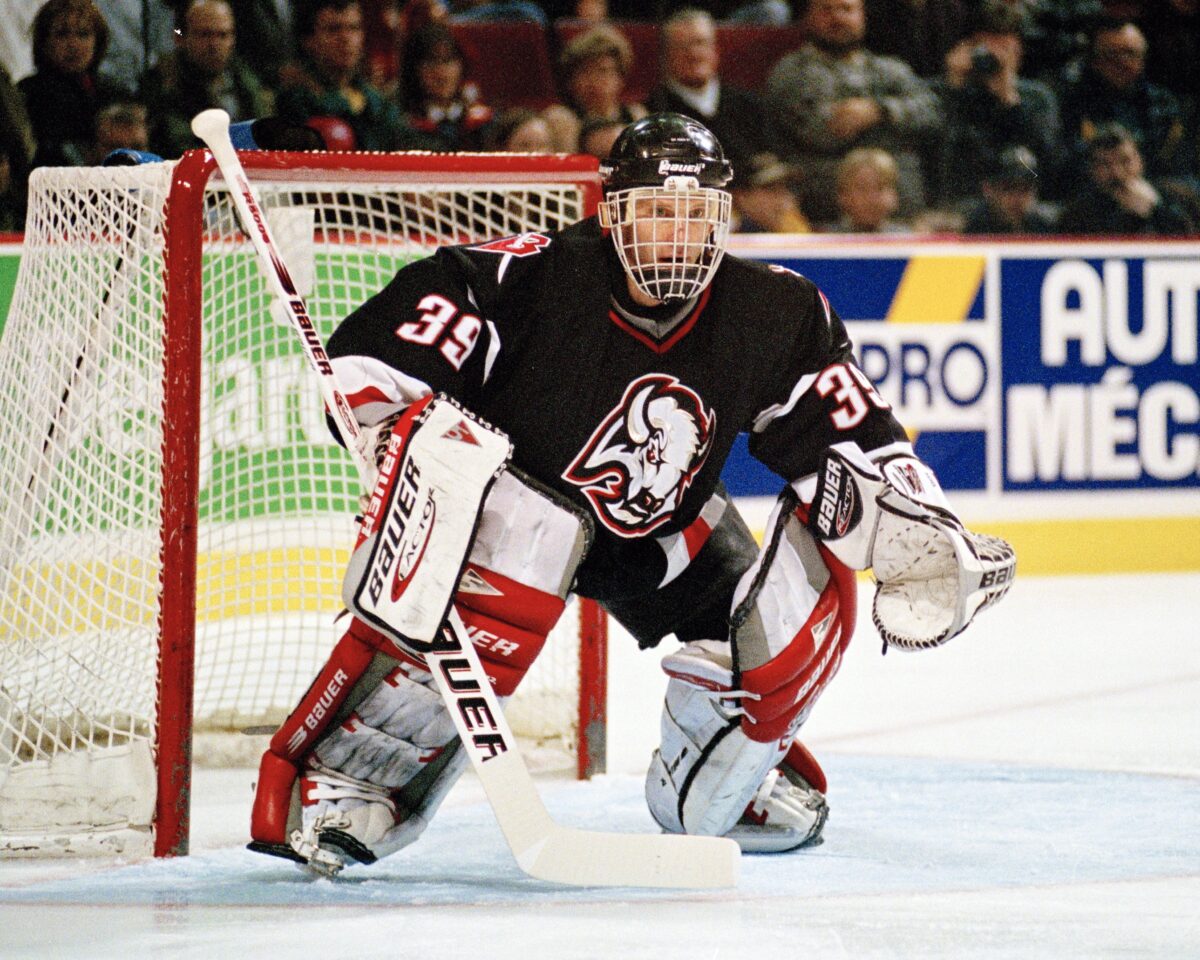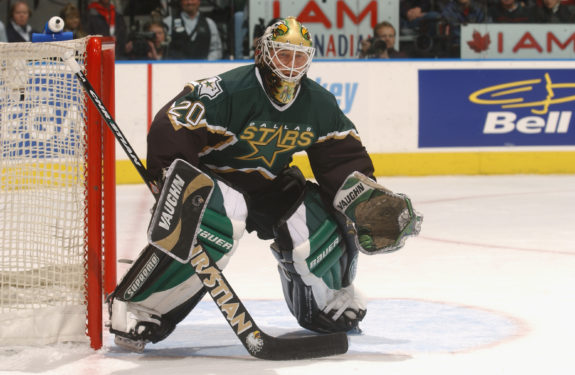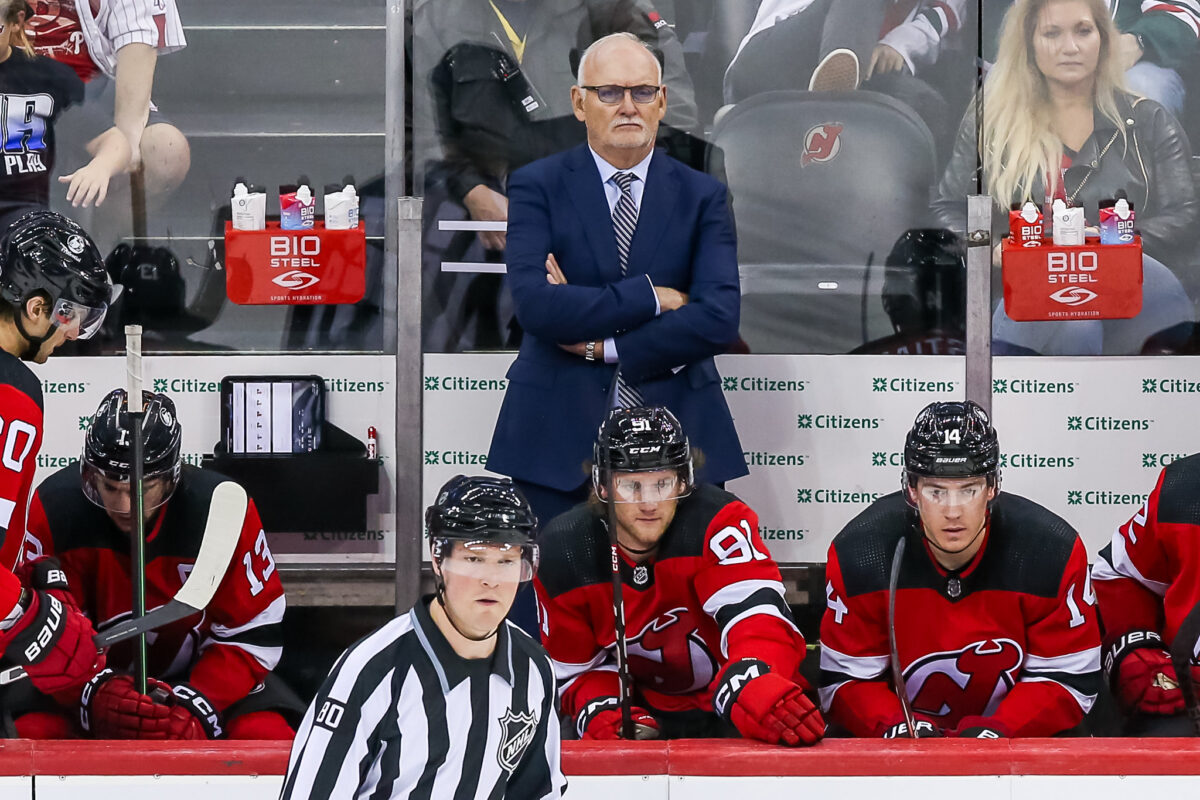Though a popular old adage states that time heals all wounds, we all know that that isn’t always the case. Sometimes the emotions brought on by a particular situation will fade away as the years go by, but there are some things that will never not be painful, and that’s certainly the case for the Buffalo Sabres.
Since 1999, two simple words have haunted hockey fans in Western New York and Southern Ontario: “No Goal”. The ending of that year’s Stanley Cup Final and the storm of controversy that ensued remain a sore spot for the Sabres and their tortured followers for a variety of reasons, and that infamous moment turns 25 today.
As the silver anniversary of that fateful day approaches, I’ve decided to re-release a feature on it that I published a couple years ago. But this time we’ll try to find an answer to one question in particular: Even after a quarter of a century, why is No Goal still such a contentious subject in Buffalo and for Sabres fans everywhere? To answer that question, we’ve first got quite a bit of backstory to dive through, I hope you brought your scuba gear!
The Sabres’ Strangest Season Ever
The Sabres have existed for 54 NHL seasons but none of them have been quite as bizarre as 1998-99. The prior season, the team advanced to the Eastern Conference Final for the first time in 18 years and looked to have a fairly good shot and winning the franchise’s first Stanley Cup. Alas, it wasn’t in the cards and the Washington Capitals prevailed in Game 6 in overtime. Despite the loss, optimism was growing in Buffalo and the hype for the next season was through the roof.
Buffalo stumbled out of the gate with a 2-3-2 start but soon caught fire and went 17-3-3 in the next 23 games to sit in first place in the East at midseason. When the calendar flipped to 1999, however, something changed. Perhaps their success went to their head, or maybe it was due to a number of significant injuries (most notably a lower-body ailment that hampered Dominik Hasek all season and kept him out for 12 games), but the Sabres plummeted in the second half and barely qualified for the playoffs, entering as the seventh seed.
The struggles gave the Sabres’ brass the impetus to improve the roster and notoriously-conservative general manager Darcy Regier actually answered the bell. Future captain Stu Barnes was acquired from the Pittsburgh Penguins and Joe Juneau, who scored the overtime winner that eliminated the Sabres from the previous spring, was acquired from the Capitals. The new pieces fit right in on an offense that actually improved significantly that season.

1998-99 dispelled the myth that the Sabres were an average team carried by the best goaltender on Earth. Miroslav Satan scored 40 goals, captain Michael Peca added 27 and Michal Grosek, Curtis Brown, Dixon Ward and Jason Wooley all recorded 40 or more points, taking pressure off Hasek and allowing him to continue his otherworldly play. Though hampered by his aforementioned injury, “the Dominator” posted a career-best 1.87 goals-against average and .937 save percentage that won him his fifth Vezina Trophy in six seasons.
Not expected to go far at all, Buffalo shocked the hockey world by making short work of the Eastern Conference playoffs. Though Satan missed a majority of the run due to a foot injury and Hasek was also unavailable at times, the Sabres took down three Northeast Division foes in the Ottawa Senators, Boston Bruins and Toronto Maple Leafs, losing just three games in that span. The Conference Final was especially intriguing as it marked the first-ever postseason Battle of the QEW. The Prince of Wales Trophy being presented to the Sabres after Game 5 in Toronto was undoubtedly a tough blow for Leaf fans.
As difficult as it would have been to imagine at the end of the regular season, Buffalo was on to its first Stanley Cup Final in 24 years, but the toughest task yet lay ahead.
David & Goliath
Many an inspirational sports movie over the years has featured a dominant, powerhouse team meeting an unlikely Cinderella underdog for the championship, and the 1999 Stanley Cup seemed to be cut from that same script. Awaiting the Sabres were the Dallas Stars, the regular season champion that finished 23 points ahead of them in the standings. Though the teams shared the commonality of not having a Stanley Cup title, their identities could not have been more split.
The Stars were a super-team, a high-flying offensive juggernaut with a battalion of firepower that featured a whopping eight future Hall of Famers (Mike Modano, Brett Hull, Joe Nieuwendyk, Guy Carbonneau, Sergei Zubov, Ed Belfour GM Bob Gainey and coach Ken Hitchcock). They wracked up 236 goals and allowed an NHL-low 168, running away with the Presidents’ Trophy. Ironically, however, their road to the Cup Final proved much more arduous and the Sabres nearly met the Colorado Avalanche instead. Dallas faced a 3-2 series deficit in the Western Final but rallied to claim the Clarence Campbell Bowl.
In stark contrast, the Sabres were a group of punishing, ground and pound battlers that forged victories through tenacity and toughness. While Satan, Peca and Ward handled the scoring duties, the likes of Rob Ray, Wayne Primeau, Randy Cunneyworth and Vaclav Varada added a gritty physical edge that consistently made the team formidable despite its perceived lack of talent. The Sabres scored only 207 goals that year (third least among teams that made the postseason), but allowed only 175 against (the second fewest behind Dallas) thanks to Hasek’s brilliance and strong defensive play.
The media didn’t see it at the time, but the pieces were in place for a memorable series and it proved to be just that.
The Belfour-Hasek Dichotomy
A fascinating aspect of the series that doesn’t get talked about nearly enough is the connection between the starting goaltenders. Ed Belfour and Dominik Hasek are both enshrined in Toronto and were quite familiar with each other before the puck dropped in Game 1.
Related: Best NHL Goalies of the 1990s
Before coming to the Stars, Belfour made his name with the Chicago Blackhawks, winning both the Calder and Vezina Trophies in 1991. And strangely enough, it was that success that led to his counterpart at the other end of the ice being where he was. Hasek came to the Blackhawks that same season but his contemporary’s dominance relegated him to the bench and he saw very limited time over the next two years. His breakthrough came in Game 4 of the 1992 Cup Final when he relieved Belfour and helped the Blackhawks rally to force overtime with a dazzling performance.

Though the Penguins eventually won and swept the series, the seeds were planted. The Sabres already knew that the Czech was something special and had attempted to trade for him earlier that season. His display in the Stanley Cup convinced them to try again and this time they succeeded, acquiring him in one of the most lopsided trades in NHL history. Chicago received goaltender Stephane Beauregard (who never played a game for either team) and a draft pick that turned out to be the talented but injury-plagued Eric Daze.
While Hasek ironically went on to have a better career, Belfour continued to shine and came to the Stars in 1997. Had “The Eagle” not gotten off to such a strong start, perhaps Hasek would have become the guy in Chicago and he would have wound up elsewhere. Whether it was serendipity or just an amazing coincidence, the goaltenders’ shared history gave added intrigue to the NHL’s last championship of the 20th century, and the two took center stage.
Buffalo Was Not Star-Struck
It should come as no surprise that the Stars were heavily favored to not only win the series, but expected to have an easy go of it. However, the Sabres were not intimidated by their towering opponent and proved it immediately in Game 1 in Dallas when Jason Woolley jumped down off the point in overtime and fired “the shot heard ’round the world”. The goal stunned the Stars and crowd alike at Reunion Arena and showed that the series would be no walk in the park.
True to form, the Stars seized the momentum right back and took the next two games before the Sabres evened it in Game 4. Belfour and Hasek were in top form all series long, with all but two games decided by one goal as both netminders put their name in the Conn Smythe Trophy conversation. In Game 5 in Dallas, Belfour posted a 2-0 shutout (albeit on just 23 shots) to put his team within a victory of the Promised Land.
The series shifted back to Buffalo with the Sabres against the wall for the first time that postseason and in desperate need of an edge. Game 6 on Saturday, June 19 became one of the most legendary contests in NHL history, but not entirely for great reasons.
The Marine Midland Arena Marathon
After Jere Lehtinen put the Stars on the board in the first period, the Sabres finally broke through for the first time since Game 4 when Stu Barnes knotted it late in the second. That would be the last goal scored for more than an hour of game time, with the third period, first and second overtimes all ending draws. As the midnight hour passed, the crowd at then-Marine Midland Arena hung on the edge of its collective seat as the action remained unbearably tense.
Both teams missed numerous chances as both goaltenders refused to yield. Buffalo’s James Patrick came agonizingly close to sending his team to a seventh game in the second overtime when he ripped a picture-perfect one-timer from the point that had Belfour beat, only for it to go off the crossbar. It was 1:30 on Wednesday morning as the third overtime approached its conclusion, a victor still yet to be decided.
Then, with the contest on the cusp of doubling its original length, Brett Hull corralled a pass at the front of the Buffalo net, dodged the backchecking Brian Holzinger and got one past Hasek for the first time in four periods to end the epic struggle and send the Stanley Cup to Texas for the first time ever. The Stars piled onto the ice to celebrate, while the Sabres could only sit and await the handshake line. Despite Belfour’s brilliance, Joe Nieuwendyk was surprisingly awarded the Conn Smythe as Postseason MVP.
But while the Stars were taking the customary lap with Lord Stanley’s chalice, Regier and head coach Lindy Ruff suddenly emerged from the Sabres’ locker room and demanded the game be restarted. Though it hadn’t been noticed immediately, an issue with the deciding goal was evident, and there was validity to the Sabres’ argument (from “‘No Goal’ was yet another agonizing result for Buffalo fans”, The Democrat & Chronicle, 6/5/2020).
Foot in the Crease
Replays showed that Hull’s foot had been in the goal crease before the puck was shot. Now in today’s NHL, nobody would think twice of it, but at the time it was a hot-button issue.
Years earlier, the NHL introduced new rules in order to give goaltenders more protection. The size of the crease in front of the net was expanded and it became illegal for a skater to be in the crease without possession of the puck. Frankly, it was a stupid rule and almost universally disliked as countless goals were overturned despite the goaltender not being obstructed. Nevertheless, the NHL stuck with the change and enforced it numerous times during the 1998-99 season.
As if the higher forces intended it, this was a situation that the rule was designed for, but it was not enforced. Despite what appeared to be a clear violation, the NHL upheld the goal and stated that since Hull had possession beforehand, he was allowed to enter (despite the replay showing that he may not have had definitive possession). Both the NHL and Hull himself (unsurprisingly) continue to insist that the call was correct.
Frequently cited was a private memorandum released earlier that season that amended the rule to allow for players to be in the crease even if the puck wasn’t – so long as possession had been maintained. However, it’s been debated how well the memo was circulated even inside the league, as the Sabres, broadcasters and analysts alike seemed to have no idea of its existence since it was for some reason never made public.
The Sabres refused to leave their locker room until given an explanation and Hasek and a number of players considered returning to the ice. Then-NHL Director of Officiating Bryan Lewis came to explain the ruling but as is common knowledge now, the team refused the reasoning it was given. Ruff was heard shouting at Gary Bettman from the bench whilst the Cup was presented to the Stars, but the commissioner paid no mind. Buffalo’s coach would not be ignored and famously stated “no goal” at a rally in Buffalo’s Niagara Square a few days later. The incident has been known as that ever since. (from “Buffalo sports’ greatest what-ifs: What if ‘No Goal’ was really no goal?”, The Buffalo News, 4/1/20).
Related: Sabres Should Use All of Their 2024 Draft Picks
Buffalonians for years have criticized the NHL’s ruling as a post hoc excuse and even a writer from The Dallas Morning News seemed to agree with them. Many have speculated that the goal would have been overturned had the Stars not already been awarded the Stanley Cup and had it not been nearly 3:00 AM. CBC and ESPN, the two networks broadcasting the game, didn’t even begin to show replays of the infraction until after Dallas was well-into its celebration. Had the Sabres raised their protest sooner, would it have stood?
It’s a truly unfortunate situation for both teams. The Sabres lost for reasons that they may not have even been aware of and were left feeling robbed. And whether Stars fans like it or not, the team’s only championship to date will always have a cloud over it, regardless of whether one believes the goal was legal or not. It will be debated until the end of time and it continues to polarize fans to this day.
Either way, it was very, very bad look for the NHL. Though likely with good intentions, the league created a largely unpopular rule that seemed to cause far more harm than good but failed to enforce it in the biggest scenario possible. Bettman was already in the process of becoming hockey’s most reviled figure ever at that time and this only added to it.
Why “No Goal” Haunts Sabres Fans
Before the 1999-00 season began, the rule was erased altogether and players were allowed to stand in the goal crease as long as the goaltender was not interfered with. The decision made the NHL look even guiltier and gave further credence to the argument that they had dropped the ball.
It’s impossible to say what would have happened had the goal not stood and it’s tough for me as a Sabres fan to accept this, but there’s no guarantee that Buffalo would have won the Stanley Cup if not. The Stars could still have gone on to win Game 6, or perhaps the Sabres would have and then lost in Game 7 in Dallas.
To be fair, it could have been possible. The Sabres weren’t expected to stand a chance in the series yet took the Stars to just about the limit, and the Stars were banged up throughout. Hitchcock revealed in 2023 that four Stars would potentially have missed Game 7 had it occurred, most notably Hull and Modano (from “Lindy Ruff, Ken Hitchcock look back as Buffalo Sabres’ ‘No Goal’ loss turns 25, The Buffalo News, 6/18/24). Given that, the Sabres may have had a chance, but we’ll just never know.

But why is it such a big deal in Buffalo? It’s been 25 years, a quarter century, and Buffalonians of all ages still look back on No Goal like it was yesterday. The simplest and most obvious reason why is because it’s the closest their Sabres have ever come to lifting the Cup and they were thwarted in part by one of the most controversial rulings in North American sports. But the deeper and darker answer is that it serves as a reminder of an unfortunate truth- the team’s legacy of failure.
Make no bones about it, the Sabres have a rich history and have produced some of the most memorable moments in the pantheon of hockey, but it’s tough to deny that they’ve become synonymous with losing. In 54 years, they’ve never played in a game in which a victory would have clinched them a championship, losing in six games in both of their Stanley Cup Final appearances to date. They haven’t even been able to make it that far in the two and half decades since, managing back-to-back Conference Finals in the mid-2000s but falling short both times. The less said about their more recent history, the better.
Though it might be hard to imagine after this past season, the Sabres will capture the Stanley Cup one day and bring salvation to their long-suffering supporters. And when that day comes, maybe, just maybe, the agony of the 1999 Final will be laid to rest. But until that day comes, we’re left with just two words: no goal.
Sign up for our NHL History Substack newsletter
